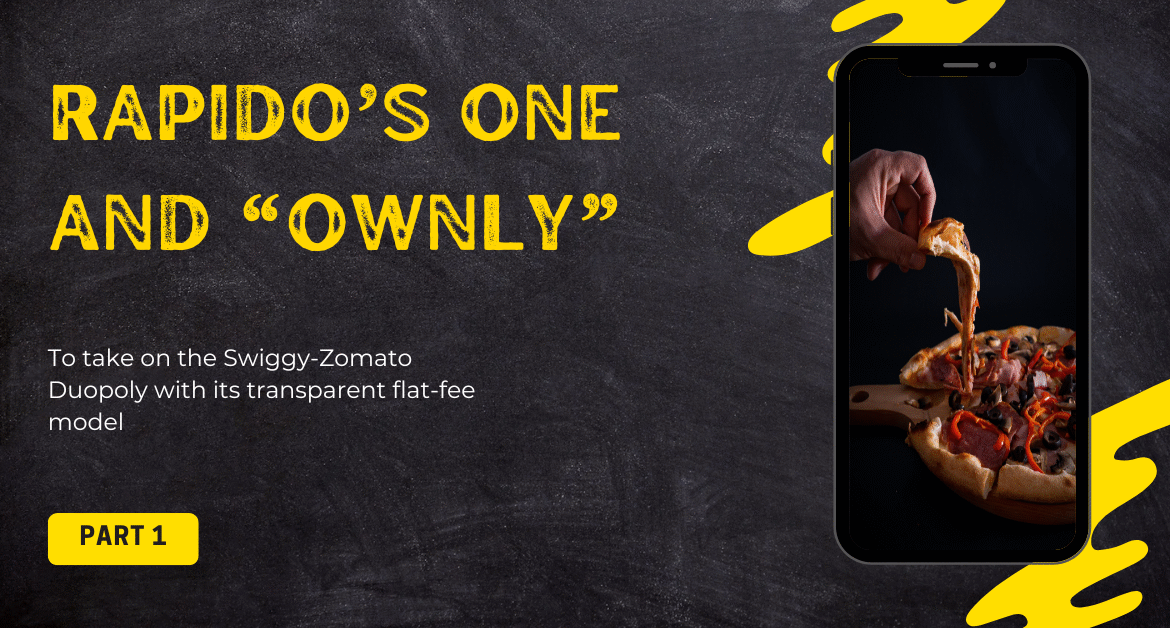“Every person should have the luxury of choice and the ability to order a reasonably priced meal.”
This is Rapido’s tagline-cum-mission as it plans to burst into the food delivery scene with “Ownly.”
With a soft launch on cards in Bengaluru in late June-early July, the ride-hailing platform is looking to shake the duopoly that Zomato and Swiggy have long enjoyed.
Rapido has joined forces with the National Restaurant Association of India (NRAI), which represents over 500,000 restaurants nationwide.
Both parties have been brainstorming with each other for the last 6 months to build the right commercial and logistic structures for partner restaurateurs and food delivery.
So, what’s so big deal about it?
Small Restaurateurs, Big Problems with Zomato and Swiggy
Zomato and Swiggy’s commission-heavy model often works against small-to-medium restaurant owners. As they handle a lower order volume than larger outlets, the high platform commissions eat into their already-thin margins.
On the flip side, large restaurant chains have greater negotiating power given their high order volumes, enabling them to negotiate sweeter deals. As such, the playing field becomes uneven where the smaller guys have to either comply or risk invisibility.
In a LinkedIn post, Vandit Malik, founder of the Garlic Bread, explained how Zomato is eating into small biz’s profits due to costly ads.

Few Challengers Entered The Kitchen….And Got Burned
Rapido isn’t the first to challenge the Swiggy-Zomato duopoly. Various ride-hailing giants have tried their best to breach India’s food delivery wall, all of which have had to retreat.
- Ola launched Ola Cafe in 2015, and later on acquired Foodpanda India in 2017. Despite heavy investment and efforts, Ola’s venture fizzled out. By 2019, it was all curtains for the ride-hailing service in the space due to operational inefficiencies and stiff competition.
- Uber launched Uber Eats India in 2017 but had to shut down its operations three years later, selling the business to Zomato in January 2020.
Rapido’s New Recipe for Food Delivery
Rapido has proposed two game-changing moves to disrupt India’s ~$55 Bn online food delivery market:
Flat Fees, Lower Commission
Rapido has introduced a three-tier pricing model. It’ll charge a fixed delivery fee of ₹50 on orders above ₹400 and ₹25 on orders totaling ₹100-400. That said, both restaurant owners and consumers will share the burden for food orders below ₹100 (cross-subsidizing). Rapido will deduct these charges from the order value. All these within a standard 4-km radius and exclusive of the GST (18%).
That means restaurants need to pay an 8-15% commission based on the average order value (AOV), a 50% slash from what Swiggy and Zomato charge from their partner restaurants: 16-30%.
Rapido’s lower commissions are appealing to small-to-mid-sized eateries that often run on large low-ticket order volumes, are price sensitive, and hence, grapple with high aggregator fees.
Online Price=Offline Price
Rapido Ownly has urged partner restaurants to price the meals on its platform the same as in dine-ins. The ride-hailing unicorn has claimed that online food delivery is expensive and the trend will only go north. Hence, most Indian consumers get shooed away.
“We will only be looking to work with partners who can commit to this stand of honest pricing.”
Said Rapido in its proposal.
So, it’s in talks with restaurateurs to list at least four dishes below ₹150 each to attract new users and make food more affordable for the existing ones. Plus, these food items will be shown more prominently to customers.
This is particularly a welcome move for the vast, price-conscious people in tier-2 and tier-3 cities, where online food delivery penetration is showing promising signs.
Besides, the affordability means restaurateurs no longer need to rely on discounts and offers to improve their visibility. All thanks to Rapido’s no-discount platform that’s planting the spotlight firmly back on product and price. Simply put, the meals will be front and center on Rapido’s food delivery app, alongside the entire menu.
How Much Your Meal Will Likely Cost on Rapido Ownly Then?
You won’t have to pay platform or packaging fees, except for a small delivery fee for orders below ₹100. And of course, the 18% GST.
So, here’s how Rapido Ownly’s move can impact your final bill:

A meal that costs ₹199 will cost ₹199 on the menu, whether online or offline (plus GST). Only ordering via the former will attract delivery fees. No platform markups, packaging, and other hidden fees (dark patterns).
But, How Will Rapido Make Profits?
I know you must be thinking about this. Rapido has answered that question.
“We hope to bring delivery costs down across the industry… Once we have brought about real structural change in delivery prices, we will look to charge a flat subscription fee from restaurants. We will always remain zero commission.”
Unlike Zomato and Swiggy, which offer ad and marketing solutions for restaurants to boost reach, Rapido will equip its partner restaurants with the data and tools necessary to offer discounts to select customers. But it has asserted not to use discounting to push down prices on the app or compel restaurateurs to do so.
A Disruptor or A Has-Been?
While Rapido might rebrand its food delivery venture in the future, the company won’t budge on its mission of offering more affordable meals to customers. Its price structure rethinking is an open challenge to Swiggy and Zomato, who have irked small restaurants with their commission-based models.
Furthermore, Rapido’s equal focus on India’s price-conscious diners can just spice up a revolution, in times where people have to trade off convenience with premium charges.
Currently carrying passengers in 100 cities, Rapido aims to serve 500 cities across India by 2025.



Comments (01)
By: Can Rapido’s Ownly Handle The Zomato-Swiggy Storm? [Part 2] - Vatsal Jain
[…] has already hogged the news headlines with its food delivery venture, “Ownly,” aiming to challenge the Zomato-Swiggy […]